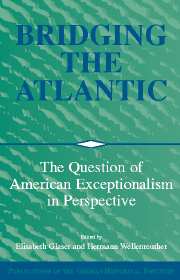Book contents
- Frontmatter
- Introduction
- Part One Transatlantic Faiths and Beliefs
- Part Two Transatlanatic Ideologies and the Perception of the Other
- Part Three People in the Transatlantic World The Perception fo Self
- 6 German Catholic Communalism and the American Civil War: Exploring the Dilemmas of Transatlantic Political Integration
- 7 Toward a Comparative History of Racism and Xenophobia in the United States and Germany, 1865-1933
- 8 Movie Stereotypes, 1890-1918: Some German and American National Perceptions
- Part Four Transatlantic Politics and Economics
- Part Five Transatlantic History and American Exceptionalism
- Index
8 - Movie Stereotypes, 1890-1918: Some German and American National Perceptions
Published online by Cambridge University Press: 05 January 2013
- Frontmatter
- Introduction
- Part One Transatlantic Faiths and Beliefs
- Part Two Transatlanatic Ideologies and the Perception of the Other
- Part Three People in the Transatlantic World The Perception fo Self
- 6 German Catholic Communalism and the American Civil War: Exploring the Dilemmas of Transatlantic Political Integration
- 7 Toward a Comparative History of Racism and Xenophobia in the United States and Germany, 1865-1933
- 8 Movie Stereotypes, 1890-1918: Some German and American National Perceptions
- Part Four Transatlantic Politics and Economics
- Part Five Transatlantic History and American Exceptionalism
- Index
Summary
Elitists in Wilhelmine Germany and Progressive-era America condemned the movies. Films were classified as low culture, inferior to classical music, serious drama, and the fine arts. Movies lacked the mark of bourgeois respectability and were snubbed by the upper classes. A Düsseldorf banker discussing a movie theater remarked: “I am not embarrassed to enter it, but I am embarrassed to emerge from it after the show.” A similar point of view held sway among many in the United States: They thought of movies as entertainment for the lower classes, “helping civilization to permeate downwards.”
Perceptions of the cinema, especially in recent years, have changed drastically. Film studies has become a major field of intellectual endeavor, with an intellectual jargon all its own. Movies have become a respectable art form. For the past few decades film has been the subject of vigorous, sometimes foolish debate as the moving image has been scrutinized almost microscopically - sometimes this study has unfortunately centered on marginalia at the edge of important substantive areas. But, as film scholar Miriam Hansen asserts, cinema “intersects and interacts with . . . public life.”
Already in the early days of what critic Walter Benjamin called “the age of mechanical reproduction” (that is, the film epoch), movies had a significant impact on public perceptions. Whatever private restrictions or official censorship may have existed in the United States and Germany, the bulk of the movies produced in both countries never lost their ability to set forth images, no matter what their character, to capture viewers. Film may be art, but even more so it is commerce – and movies, with rare exceptions, were produced to capture an audience, to provide a return on investment. Whatever ambivalent images such movies may now project, at the time of their release the producers in both countries did not intend to alienate viewers.
- Type
- Chapter
- Information
- Bridging the AtlanticThe Question of American Exceptionalism in Perspective, pp. 181 - 208Publisher: Cambridge University PressPrint publication year: 2002

